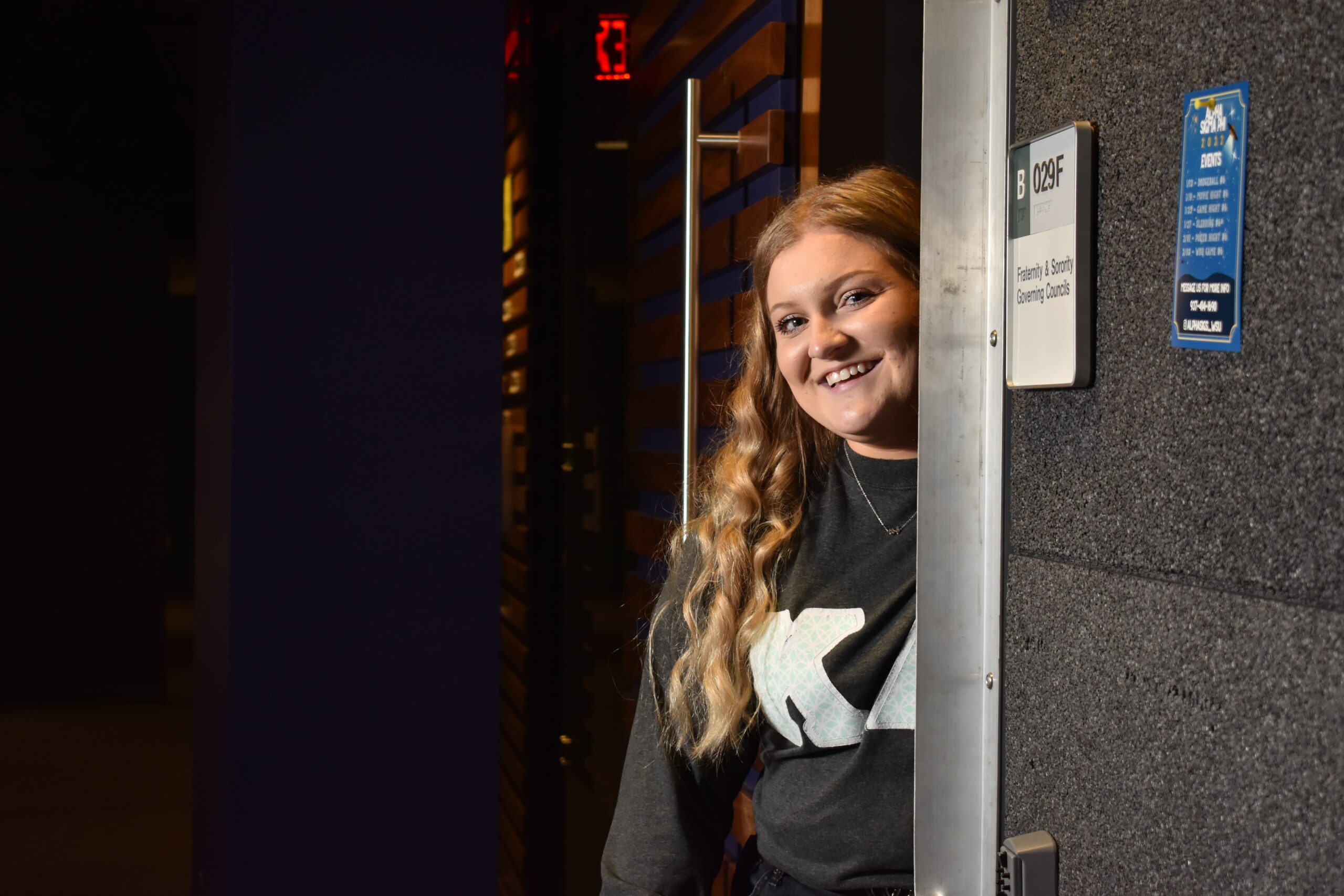
Jeff Shehee | Photo by Dylan Collison | The Wright State Guardian
Wright State is suffering from a culture of burnout.
Some of the most impactful members of the Wright State community don’t even have a college degree. Yet, they carry the burden of planning and staffing massive student engagement events, driving the administration to make better decisions and performing up to insurmountable expectations.
“Student organizations as a whole, but especially student leaders, I truly believe that they’re the heart and soul of the university,” Jeremy Keller, leadership program manager in the Office of Student Involvement and Leadership, said.
Student leaders define the culture and atmosphere of the university.
“Without these student leaders, it would be: come to school, go home, come to school, go home. There would be nothing in between,” Gina Keucher, fraternity and sorority life program director, said.
Students step into leadership roles because they enjoy the work and feel a sense of responsibility for their specific organization. However, they can be overwhelmed by the sheer workload and pressure of what is expected of them. After all, student leaders are students, and many of them have to carry the duties of living independently and going to college full time.
“We do what we do because we love it,” Parker Testa, sports director at WWSU 106.9 FM, the university’s student-run radio station, said. “If there was no class required to be here, I would still be here the same amount of time I am now because I really just enjoy it that much.”

Whether students join organizations to meet new people, gain resume experience or build their confidence, each student chooses to be a part of something bigger than themselves. That choice does sometimes come with a price.
For Testa, being a leader at the radio station does not stop when he leaves the studio. He also worked for Wright State’s Office of Admissions and volunteers to help at other university-wide events such as the Halloween Bash.
Multiple student organizations collaborated to organize a six-hour-long Halloween event for students that included glow in the dark mini-golf, a costume contest, live music, a haunted house and more. After calling multiple sports games the week leading up to volunteering for the bash, Testa arrived at WWSU at 9 a.m. Saturday and did not leave campus until after the bash ended at 1 a.m. Sunday.
“I think they look at us, especially in my department, and they think I go to basketball games and go home, and that is all I do, and that’s not true,” Testa said. “I think that’s what people don’t understand, the long hours —in all organizations— the commitment that it takes to be an org leader.”
The time Testa dedicates to the university and WWSU constantly battles with the 30-plus hours a week he works as a producer at WHIO 1290 AM and 95.7 FM.
Testa is not alone.
Many organization leaders on campus struggle to lead their organization, do well in class and work other jobs on the side to support themselves through school.
Kaci Lovejoy is president of College Panhellenic and holds leadership positions within her sorority chapter, Kappa Delta.

“Even within my own chapter, we have a thing called appointed officer positions. Normally people get like three or four. I have seven,” Lovejoy said.
On top of her 19-plus credit hours as a vocal performance major and a part-time job outside of school, Lovejoy says it becomes difficult to draw the line between her involvement and her classes.
“I’ve definitely thought about dropping out of my own chapter, just from everything piling up,” Lovejoy said. “It’s a lot to take on. It gets to the point where I am so enthralled in what I’m doing as a student leader that I kind of lose sight of my classes.”
Student leaders are struggling.
And the struggle becomes increasingly difficult when the same small group of students is taking on all the responsibilities of multiple positions in multiple different organizations.
According to Courtney Laukitis, student organizations program manager, there are currently 130 total student organizations on campus.
These organizations consist of 364 leadership positions filled. These only include the president, vice president, treasurer and secretary.
Of these 364 student leaders, 315 are unique leaders, which means that 49 of these students hold leadership positions in two or more organizations.
Even more shocking, the number of student leaders on campus makes up only 3% of the total student population at the Dayton campus.
And the situation is getting worse, especially since the pandemic started.
“I will tell you that previously, I probably had maybe one student leader a year tell me that they were mentally not OK. This year it is meeting after meeting,” Keucher said. “I’ve seen everything from someone feeling like they need to go to the hospital to someone crying in my office or admitting that they’re not eating or someone saying ‘I just can’t take it anymore,’ and then they go from being a leader to someone who is willing to give that up.”
Many student leaders are drowning, and they don’t see any solutions on the horizon.
“The problem is, you used to have a support system. You used to have five people underneath you who would step in and take some of that load. I think what’s happening with leaders right now is there aren’t that many people stepping up to take the load, right? They feel like, ‘If I don’t do this, nobody will.’ And so instead of saying ‘oh then nobody does it,’ they are putting that on themselves,” Keucher said.
Keucher says she has noticed a weird gap of leaders in the sophomore and junior classes.
Instead of having opportunities to meet mentors and develop friendships, many of these students struggled with online learning and picked up more hours at a job to fill their time.
The lack of support from younger students could be due to the COVID-19 pandemic. Many students spent most of their first and second years online, leaving little room to meet current leaders, get involved or develop a desire to step up and lead.
However, ‘Generation Z’ research conducted by professor Corey Seemiller shows this might not be the case.
Her in-depth research on Gen Z indicates that even before COVID, they were not stepping up into leadership roles as much as previous generations.
According to Seemiller, Gen Z prefers to enjoy general membership but not necessarily lead organizations. They also may be more willing to take on shared leadership roles or leadership positions that do not bind them for long periods.
Some students will not care for the extra work or the extra title.
“With the cost of higher education, it is common for students to work… and for Gen Z, work a lot. Some might simply not have enough time to sacrifice hours at work to take on a leadership role, even if it is paid, likely not what they are making at their jobs. Some may have decided to take more classes than usual to finish their degrees more quickly to save tuition dollars. Some may just not want the extra stress during what is a stressful era of time,” Seemiller said.
Whether the issue is long-term or temporary, caused by COVID-19 or not, some student leaders have come up with a phrase to describe their struggle: overworked, underpaid, underappreciated.
Although blunt, some feel that there is some validity to the statement.
Some students, such as Senior Jeff Shehee, are involved in seven-plus different organizations on campus and hold leadership positions in almost all of them. As a leader, Shehee not only has his responsibilities on a day-to-day basis but takes it upon himself to check up on his other members to make sure they have what they need to thrive.

“Our job as executive members is to check up on everybody below us, but nobody ever comes back to check up on us. Just because I’m getting paid doesn’t mean I’m OK,” Shehee said.
“I think we overwork ourselves because that is just the norm we are used to at this point,” Shehee said. “It’s OK to be overworked every once in a while, but after you spend so long filling in everybody else’s holes, you’re just used to it. Your mind and your brain kind of just go numb and there is nothing else for you to do except continue to fill those holes and just hope that something gets better. But I think you officially begin to feel underappreciated after you fill those holes and nobody says thank you or even recognizes that you did anything at all.”
So, where should students draw the line? If everything rises and falls with leadership, where does that put Wright State’s student body? The community?
The burnout issue is a complicated one, with many layers and causes.
Maybe student leaders are short-handed and overwhelmed.
Maybe student leaders put too much pressure on themselves
Maybe student leaders don’t know how to say no.
Either way, student leaders are struggling with burnout, and they sure as hell are not the only ones.
